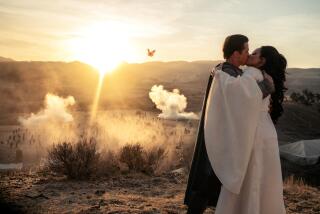Steering clear of troubled waters
What’s more frightening than scuba diving in pitch-black water? How about scuba diving in pitch-black water dotted with explosive mines?
During his 14 years as a bomb disposal diver in the British Royal Navy, 37-year-old Daren Bailey routinely placed himself in dangerous situations involving live explosives. “There’s still a big problem with Second World War mines around the coast of England,” he says. “A lot of German mines keep coming up, so we have to deal with that quite a lot.”
Although Bailey found the work exciting when he was in his 20s, in time his feeling of invincibility began to wear thin. When a friend of his brother’s informed him that Hollywood needed people with boating and diving expertise, he left the military and went straight to the set of “Captain Corelli’s Mandolin.” Since then, Bailey has lent his sea legs to films including “The Life Aquatic With Steve Zissou,” “Syriana,” “Stardust,” “Elizabeth: The Golden Age” and “The Golden Compass.” Recently, he worked as the marine coordinator on “Rambo,” due in theaters Friday. In this latest installment, Sylvester Stallone reprises his famous role as John Rambo, who is recruited by missionaries working in Burma to protect them against pirates -- who hardly limit their adventures to the Caribbean these days.
Drowning in paperwork: Bailey doesn’t have a desk job, but he has to fill out his fair share of forms. “With all the health and safety issues, it takes at least two weeks just to insure the boats and do all the risk assessments,” he says. “But once you’ve got that out of the way, then you can just look forward to getting out on the water and being with the guys and doing all of the sailing stuff.”
Ships, ahoy!: For “Rambo,” Bailey was in charge of what amounted to a small navy. “It was roughly about 25 boats in the water at one time,” he says. “We had four Burmese patrol boats. So we’re advising on how they used to fire weapons and how they’d turn the boat around a corner. And then there’s the pirate boats and Rambo’s longboats -- one for blowing up, one [where we] did all the dialogue onboard the boat. And then we had ferry boats that came out onto the set and catering boats, safety boats, location boats, special effects boats.”
The jungle crews: Complicating matters, roughly half of the film’s Thai crew didn’t know how to swim, so water safety was the No. 1 priority on the shoot. “A few people fell in, but it was just at the very beginning, which we were doing on a shallow river,” says Bailey. “We had a brief with everybody because with the shallows, it wasn’t too bad, but we knew we had to go to the [Mae Ngud Dam in Sri Lanna National Park in Chiang Mai]. The dam’s 1,000 feet deep. You’ve got crew that can’t swim, and there’s rigging belts and the camera and lighting. So if they were to fall in there, they wouldn’t have much chance. The crew, they work so fast that they just need to slow down and be aware of their environment.”
Teetotal disaster: If there’s one thing worse than a hangover, it’s a hangover on a ship. While the crew on the calm waters of the Mae Ngud Dam didn’t have to contend with seasickness, the riggers on “Elizabeth: The Golden Age” faced rough seas. “One of the things you always say to the crew is, before we go to sea, ‘Please do not drink the night before because even a glass of wine or some beer, it will weaken the stomach.’ We had some tough riggers who do all the scaffolding rigs for the camera unit. Big blokes. Big, strong, bear-armed gents. They went out the night before and went drinking. I had to take them off the ship, because they were losing too much fluid. Some of the boys had to take them back to the harbor and just stick them on dry land, really.”
More to Read
Sign up for The Wild
We’ll help you find the best places to hike, bike and run, as well as the perfect silent spots for meditation and yoga.
You may occasionally receive promotional content from the Los Angeles Times.






